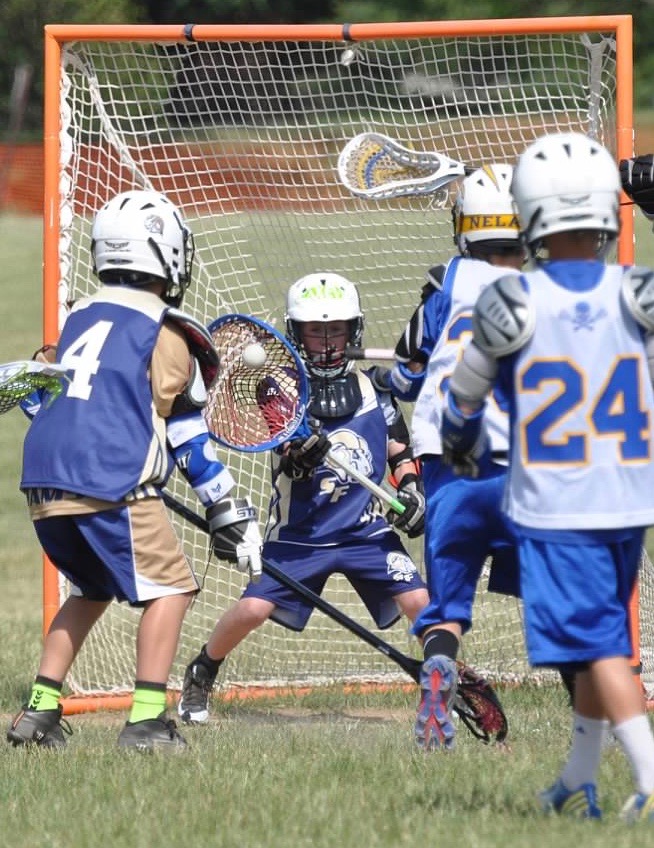Lacrosse Historical Timeline
1636 - Jesuit Missionary Jean de Brebeuf is the first to document the game of lacrosse
1794 - A match between the Seneca and Mohawks results in the creating of basic rules.
1834 - Caughnawaga Indians demonstrate the sport in Montreal. The game is reported by the newspaper and, for the first time, white men are interested in the sport.
1867 - Dr. William George Beers, the father of modern lacrosse, finalizes the first set of playing rules for the Montreal Club.
1876 - Queen Victoria watched and "endorses" a lacrosse game in Windsor, England. New York University is the first college in the United States to establish a lacrosse team.
1881 - The first intercollegiate tournament is held at Westchester Polo Grounds in New York.
1890 - The first women's lacrosse game is played at St. Leonard's School in St. Andrew's, Scotland.
1904 - Lacrosse is first played as an actual event in the Olympics in St. Louis, with Canada winning the gold medal. The United States Intercollegiate Lacrosse League is formed. Laurie D. Cox, William C. Schmeisser and Charles Lattig form a committee to develop a uniform code of operation for college lacrosse, and divide the colleges into north and south divisions.
1908 - Lacrosse is played for the last time as an actual Olympic event in London, and Canada again wins the gold medal.
1926 - Rosabelle Sinclair reestablishes women's lacrosse in the United States when she starts a team at the Bryn Mawr School in Baltimore.
1931 - The United States Women's Lacrosse Association (USWLA) is formed as the rule-making body for women's lacrosse.
1933 - The USWLA holds its first national tournament in Greenwich, Conn.
1937 - Robert Pool introduces the first double-walled wooden stick, an early prototype for today's plastic sticks.
1947 - The men's field game positions change from goalkeeper, point, cover point, first defense, second defense, center, second attack, first attack and in home to goal keeper, attack, midfield and defense.
1959 - The Lacrosse Foundation is incorporated as the sport's national development center and archive.
1967 - Coach Willis Bilderback of Navy wins his eighth consecutive intercollegiate title.
1971 - Men's College lacrosse allies with the NCAA. The International Federation of Women's Lacrosse Association (IFWLA) is founded.
1978 - The first issue of Lacrosse Magazine is published by The Lacrosse Foundation.
1982 - The first NCAA women's championship is played at Trenton State University between the University of Massachusetts and Trenton State University.
1985 - The Rocky Mountain Lacrosse Foundation becomes the first of many regional chapters of The Lacrosse Foundation. The Japan Lacrosse Association is formed. The major Indoor Lacrosse League revives professional box lacrosse in Baltimore, New York, Philadelphia and Washington.
1990 - Coach Roy Simmons, Jr. of Syracuse University is the first coach to win four NCAA titles.
1997 - The University of Maryland wins it's fifth NCAA women's championship. US Lacrosse is founded and incorporated as the national governing body of men's and women's lacrosse. On March 14, the new Lacrosse Museum and National Hall of Fame are rededicated, completing the expansion of the US Lacrosse headquarters.
2001 - The IFWLA World Cup is played in High Wycombe, England where the U.S. defeated Australia for the cup.
2002 - The International Lacrosse Federation World Championship is played in Perth, Australia. The U.S. defeats Canada for the championship.
2003 - The ILF and IFWLA U-19 World Championships are held in Towson, Maryland (U.S.) where the U.S. teams won both titles.
2005 - The IFWLA World Cup is played in Annapolis, Maryland (U.S.) and won by Australia, which defeated the U.S. 14-7 in the gold medal game.
2006 - The International Lacrosse Federation World Championship is played in London, Ontario (Canada). The Canadians win the title with a 15-10 victory over the U.S. in the gold medal game, snapping the American men's 38-game winning streak, dating back to 1978.
A History of Lacrosse
By Thomas Vennum Jr.
Author of American Indian Lacrosse: Little Brother of War
Lacrosse was one of many varieties of indigenous stickball games being played by American Indians at the time of European contact. Almost exclusively a male team sport, it is distinguished from the others, such as field hockey or shinny, by the use of a netted racquet with which to pick the ball off the ground, throw, catch and convey it into or past a goal to score a point. The cardinal rule in all varieties of lacrosse was that the ball, with few exceptions, must not be touched with the hands.
Early data on lacrosse, from missionaries such as French Jesuits in Huron country in the 1630s and English explorers, such as Jonathan Carver in the mid-eighteenth century Great Lakes area, are scant and often conflicting. They inform us mostly about team size, equipment used, the duration of games and length of playing fields but tell us almost nothing about stickhandling, game strategy, or the rules of play. The oldest surviving sticks date only from the first quarter of the nineteenth century, and the first detailed reports on Indian lacrosse are even later. George Beers provided good information on Mohawk playing techniques in his Lacrosse (1869), while James Mooney in the American Anthropologist (1890) described in detail the "[Eastern] Cherokee Ball-Play," including its legendary basis, elaborate rituals, and the rules and manner of play.
Given the paucity of early data, we shall probably never be able to reconstruct the history of the sport. Attempts to connect it to the rubber-ball games of Meso-America or to a perhaps older game using a single post surmounted by some animal effigy and played together by men and women remain speculative. As can best be determined, the distribution of lacrosse shows it to have been played throughout the eastern half of North America, mostly by tribes in the southeast, around the western Great Lakes, and in the St. Lawrence Valley area. Its presence today in Oklahoma and other states west of the Mississippi reflects tribal removals to those areas in the nineteenth century. Although isolated reports exist of some form of lacrosse among northern California and British Columbia tribes, their late date brings into question any widespread diffusion of the sport on the west coast.
On the basis of the equipment, the type of goal used and the stick-handling techniques, it is possible to discern three basic forms of lacrosse—the southeastern, Great Lakes, and Iroquoian. Among southeastern tribes (Cherokee, Choctaw, Chickasaw, Creek, Seminole, Yuchi and others), a double-stick version of the game is still practiced. A two-and-a half foot stick is held in each hand, and the soft, small deerskin ball is retrieved and cupped between them. Great Lakes players (Ojibwe, Menominee, Potawatomi, Sauk, Fox, Miami, Winnebago, Santee Dakota and others) used a single three-foot stick. It terminates in a round, closed pocket about three to four inches in diameter, scarcely larger than the ball, which was usually made of wood, charred and scraped to shape. The northeastern stick, found among Iroquoian and New England tribes, is the progenitor of all present-day sticks, both in box as well as field lacrosse. The longest of the three—usually more than three feet—it was characterized by its shaft ending in a sort of crook and a large, flat triangular surface of webbing extending as much as two-thirds the length of the stick. Where the outermost string meets the shaft, it forms the pocket of the stick.
Lacrosse was given its name by early French settlers, using the generic term for any game played with a curved stick (crosse) and a ball. Native terminology, however, tends to describe more the technique (cf. Onondaga DEHUNTSHIGWA'ES, "men hit a rounded object") or, especially in the southeast, to underscore the game's aspects of war surrogacy ("little brother of war"). There is no evidence of non-Indians taking up the game until the mid-nineteenth century, when English-speaking Montrealers adopted the Mohawk game they were familiar with from Caughnawauga and Akwesasne, attempted to "civilize" the sport with a new set of rules and organize into amateur clubs. Once the game quickly grew in popularity in Canada, it began to be exported throughout the Commonwealth, as non-native teams traveled to Europe for exhibition matches against Iroquois players. Ironically, because Indians had to charge money in order to travel, they were excluded as "professionals" from international competition for more than a century. Only with the formation of the Iroquois Nationals in the 1980s did they successfully break this barrier and become eligible to compete in World Games.
Apart from its recreational function, lacrosse traditionally played a more serious role in Indian culture. Its origins are rooted in legend, and the game continues to be used for curative purposes and surrounded with ceremony. Game equipment and players are still ritually prepared by conjurers, and team selection and victory are often considered supernaturally controlled. In the past, lacrosse also served to vent aggression, and territorial disputes between tribes were sometimes settled with a game, although not always amicably. A Creek versus Choctaw game around 1790 to determine rights over a beaver pond broke out into a violent battle when the Creeks were declared winners. Still, while the majority of the games ended peaceably, much of the ceremonialism surrounding their preparations and the rituals required of the players were identical to those practiced before departing on the warpath.
A number of factors led to the demise of lacrosse in many areas by the late nineteenth century. Wagering on games had always been integral to an Indian community's involvement, but when betting and violence saw an increase as traditional Indian culture was eroding, it sparked opposition to lacrosse from government officials and missionaries. The games were felt to interfere with church attendance and the wagering to have an impoverishing effect on the Indians. When Oklahoma Choctaw began to attach lead weights to their sticks around 1900 to use them as skull-crackers, the game was outright banned.
Meanwhile, the spread of nonnative lacrosse from the Montreal area eventually led to its position today worldwide as one of the fastest growing sports (more than half a million players), controlled by official regulations and played with manufactured rather than hand-made equipment—the aluminum shafted stick with its plastic head, for example. While the Great Lakes traditional game died out by 1950, the Iroquois and southeastern tribes continue to play their own forms of lacrosse. Ironically, the field lacrosse game of nonnative women today most closely resembles the Indian game of the past, retaining the wooden stick, lacking the protective gear and demarcated sidelines of the men's game, and tending towards mass attack rather than field positions and offsides.
Bibliography:
Culin, Stewart. "Games of the North American Indians." In Twenty-fourth Annual Report of the Bureau of American Ethnology, 1902-1903, pp. 1-840. Washington, D.C.: Government Printing Office, 1907.
Fogelson, Raymond. "The Cherokee Ball Game: A Study in Southeastern Ethnology." Ph.D. dissertation, University of Pennsylvania, 1962.
Vennum, Thomas Jr. American Indian Lacrosse: Little Brother of War. Washington, DC and London: Smithsonian Institution Press, 1994.
